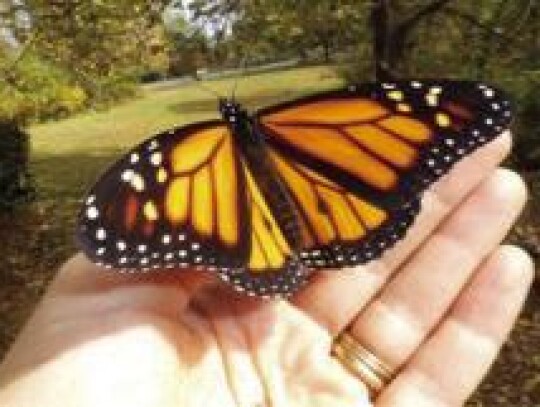Central Texas welcomes spring with the arrival of the beautiful monarch butterfly. Distinctively patterned in shades of orange, with black veins and white spots, these magical beauties can fly about 25 miles a day by taking advantage of thermal updrafts and tailwinds. They are expert gliders and by flapping their large wings more slowly than average butterflies, monarchs save energy and can travel farther.
Their story begins in the oyamel fir forests in Central Mexico where the monarch overwinters after a long migration from Canada and the northern United States. The monarch is a powerful symbol associated with the return of departed spirits and the Day of the Dead, a holiday traditionally celebrated on the first two days in November, coinciding with the butterflies’ arrival in Mexico.
The monarchs gather on the fir trees and tightly pack themselves together, so they are well camouflaged to resemble a strange bark. In this unique mountain forest, which is sadly endangered now, they will remain protected until they awaken and emerge in mid-February when the days are longer and warmer. They float down out of the trees like clouds of huge orange snowflakes and feed on the flowering plants in the area.
Then they begin their journey north to Central Texas, where there is also an abundance of flowering plants in the spring to provide nectar for the butterflies to feast on. It is where they’ll look for partners and equally important, milkweed, the only plant their larva (little caterpillars) can eat. Mating abounds and the eggs are laid on the milkweed. Females can lay as many as 450 eggs. With this important mission accomplished, the generation of monarchs that migrated from Mexico now finishes its lifespan.
Another generation of monarchs will now be nourished by the essential milkweed plant. Although the common name “milkweed” contributes to the impression that the plant is just another plain and sometimes invasive weed, it is not a weed at all; rather it belongs to a diverse group of native wildflowers and is often quite lovely. More importantly, once we understand that the milkweed plant is the nursery for the tiny caterpillars, we realize that it is actually a diamond in the rough fulfilling a crucial role in the life cycle of the magnificent monarch.
One of the primary native species of milkweed here in Central Texas is Antelope Horn, a rugged variety that grows in open fields and pastures. The larvae are fairly safely attached to milkweed leaves, which are mildly toxic and distasteful to most animals, thus reducing the larva’s exposure to predators. After about three days, the egg on the milkweed hatches, and in about two weeks the larva becomes a very fat, black-and yellow-striped caterpillar. Soon the caterpillar seeks out higher ground and attaches itself before forming a chrysalis, which looks like a beautiful piece of translucent jade with gold filigree. After the chrysalis loses its bright green color and appears much darker, although it’s actually transparent, an orange and black monarch emerges to complete its metamorphosis.
This generation of young monarchs will travel north feeding on nectar from goldenrod and other native plants, seeking out milkweed native to the Midwest, and repeating the process of mating and depositing eggs. Another generation will die and the next will continue to travel north. It takes two to three generations to reach their destination in the northern United States and parts of Canada. The generation born in the north will then fatten up as best they can and begin a very long trip to Mexico. They arrive in Central Texas around September on their way back to the oyamel fir trees in Mexico. These Texas monarchs are very special because they are the travelers that lived the longest and traveled the farthest. The generation born in the north comes through on their way to Mexico and the very same generation returns in the spring.
Monarchs were declared endangered in 2022. They are declining from loss of habitat and disease. Supporting and growing native milkweed is essential, especially native species such as Perennis, Viridis, Texana, Incarnata and Antelope Horn. Tropical milkweed is easy to propagate and often sold at local nurseries. However, it poses many health risks for Monarchs and is discouraged as a substitute for native species. Butterflies need many flowering plants for nectar. When you support your local milkweed, you will also support your beautiful monarch butterflies.
March, September and sometimes October are the best months to spot these beauties in Central Texas, so keep a lookout.







